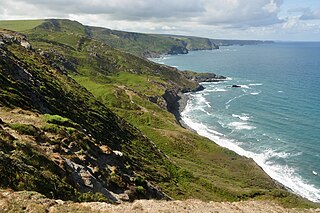Related Research Articles

Crambe maritima, common name sea kale, seakale or crambe, is a species of halophytic (salt-tolerant) flowering plant in the genus Crambe of the family Brassicaceae. It grows wild along the coasts of mainland Europe and the British Isles.

Aire Point to Carrick Du SSSI is a Site of Special Scientific Interest on the Penwith Peninsula, Cornwall, England. It is 5.98 square kilometres in extent, stretching from grid reference SW360279 to grid reference SW513410. The site is designated both for its biological and its geological interest.
British NVC community SM10 is one of the salt-marsh communities in the British National Vegetation Classification system.
This article gives an overview of the maritime cliff communities in the British National Vegetation Classification system.
British NVC community MC7 is one of the maritime cliff communities in the British National Vegetation Classification system. It is one of two communities associated with sea-bird cliffs.
NVC community SD1 is the only shingle community in the British National Vegetation Classification system.
British NVC community MC6 is one of the maritime cliff communities in the British National Vegetation Classification system. It is one of two communities associated with sea-bird cliffs.
NVC community H7 is one of the heath communities in the British National Vegetation Classification system. It is one of two communities categorised as maritime heaths.
British NVC community MC10 is one of the maritime cliff communities in the British National Vegetation Classification system. It is one of five communities categorised as maritime sea-cliff grasslands.
British NVC community MC3 is one of the maritime cliff communities in the British National Vegetation Classification system. It is one of five communities categorised as maritime cliff crevice and ledge communities.
NVC community SD2 is one of two strandline community in the British National Vegetation Classification system.
NVC community SD3 is one of two strandline community in the British National Vegetation Classification system.
British NVC community OV41 is one of the open habitat communities in the British National Vegetation Classification system. It is one of six communities of crevice, scree and spoil vegetation.
British NVC community MC1 is one of the maritime cliff communities in the British National Vegetation Classification system. It is one of five communities categorised as maritime cliff crevice and ledge communities.
British NVC community MC4 is one of the maritime cliff communities in the British National Vegetation Classification system. It is one of five communities categorised as maritime cliff crevice and ledge communities.
British NVC community MC5 is one of the maritime cliff communities in the British National Vegetation Classification system. It is one of five communities categorised as maritime cliff crevice and ledge communities.
British NVC community MC12 is one of the maritime cliff communities in the British National Vegetation Classification system. It is one of five communities categorised as maritime sea-cliff grasslands.

Boscastle to Widemouth is a coastal Site of Special Scientific Interest (SSSI) in Cornwall, England, noted for its biological and geological characteristics. The Dizzard dwarf oak woodland is unique and of international importance for its lichen communities, with 131 species recorded.

Ligusticum scoticum, known as Scots lovage, or Scottish licorice-root, is a perennial flowering plant in the celery family Apiaceae found near the coasts of northern Europe and north-eastern North America. It grows up to 60 centimetres (24 in) tall and is found in rock crevices and cliff-top grassland. It is closely related to, and possibly conspecific with, Ligusticum hultenii from the coast of the northern Pacific Ocean. The plant is edible and contains the compound sotolon, which is also present in fenugreek. The leaves have a flavour similar to parsley or celery, while the seeds taste similar to fenugreek or cumin.
References
- Rodwell, J. S. (2000) British Plant Communities Volume 5 - Maritime communities and vegetation of open habitats ISBN 0-521-39167-9 (hardback), ISBN 0-521-64476-3 (paperback)